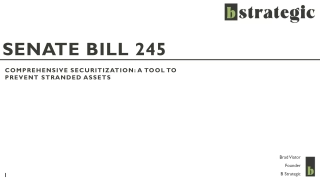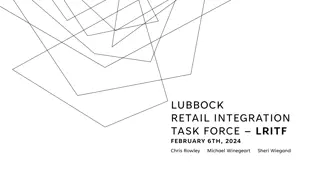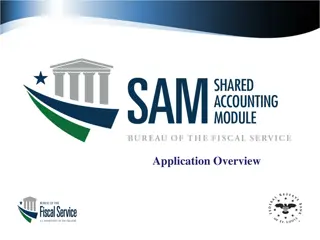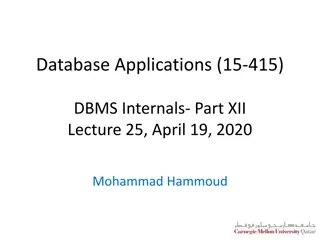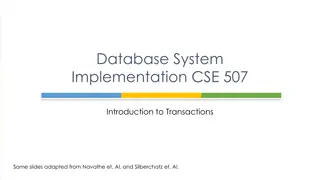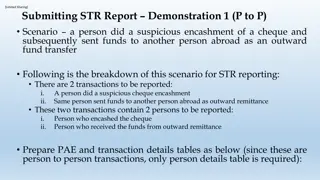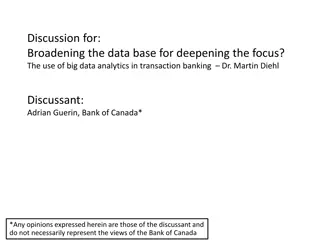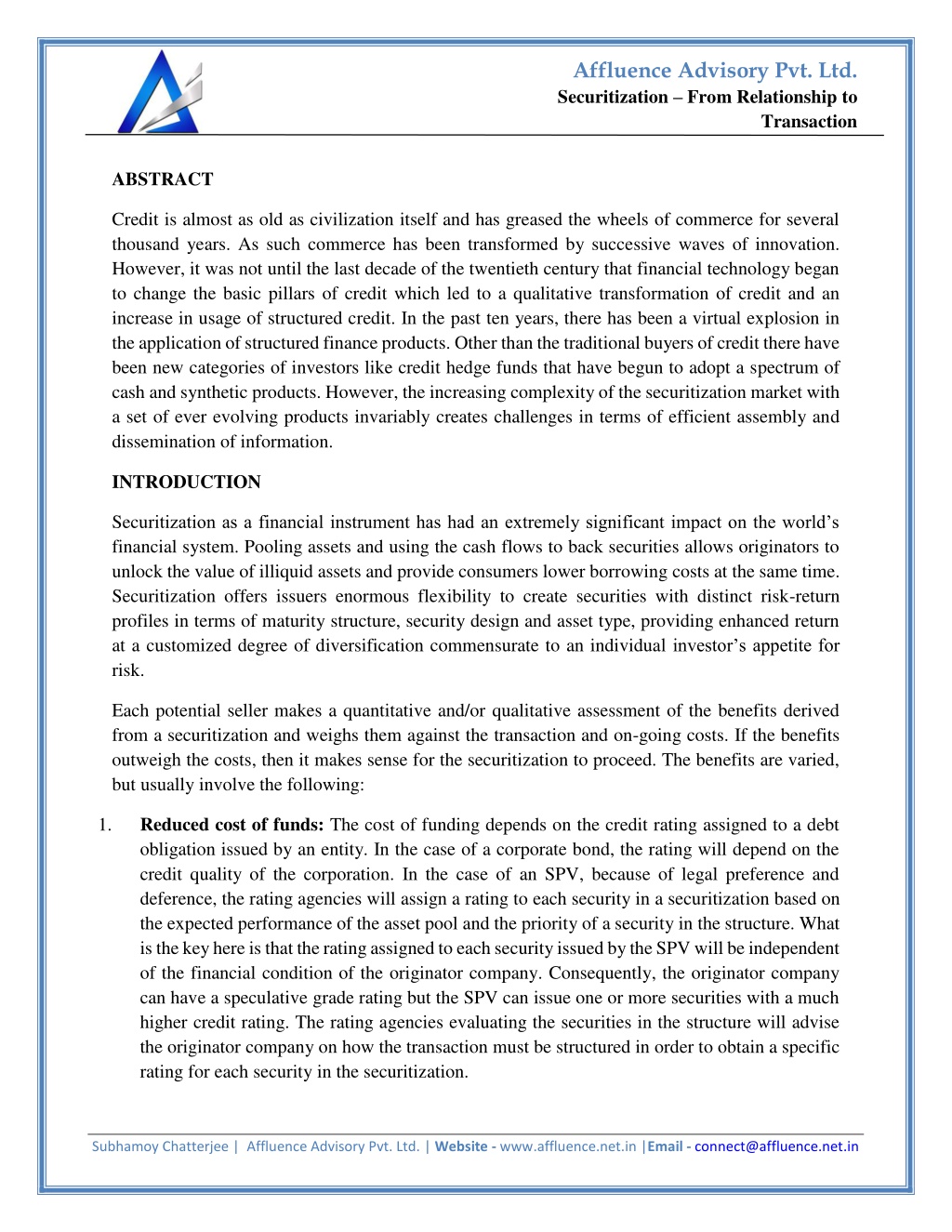
Securitization – From Relationship to Transaction
Securitization allows originators to convert illiquid assets into marketable securities, offering significant benefits like reduced borrowing costs and diversified funding sources. It provides issuers with flexibility to create securities with distin
Download Presentation

Please find below an Image/Link to download the presentation.
The content on the website is provided AS IS for your information and personal use only. It may not be sold, licensed, or shared on other websites without obtaining consent from the author. If you encounter any issues during the download, it is possible that the publisher has removed the file from their server.
You are allowed to download the files provided on this website for personal or commercial use, subject to the condition that they are used lawfully. All files are the property of their respective owners.
The content on the website is provided AS IS for your information and personal use only. It may not be sold, licensed, or shared on other websites without obtaining consent from the author.
E N D
Presentation Transcript
Affluence Advisory Pvt. Ltd. Securitization From Relationship to Transaction ABSTRACT Credit is almost as old as civilization itself and has greased the wheels of commerce for several thousand years. As such commerce has been transformed by successive waves of innovation. However, it was not until the last decade of the twentieth century that financial technology began to change the basic pillars of credit which led to a qualitative transformation of credit and an increase in usage of structured credit. In the past ten years, there has been a virtual explosion in the application of structured finance products. Other than the traditional buyers of credit there have been new categories of investors like credit hedge funds that have begun to adopt a spectrum of cash and synthetic products. However, the increasing complexity of the securitization market with a set of ever evolving products invariably creates challenges in terms of efficient assembly and dissemination of information. INTRODUCTION Securitization as a financial instrument has had an extremely significant impact on the world s financial system. Pooling assets and using the cash flows to back securities allows originators to unlock the value of illiquid assets and provide consumers lower borrowing costs at the same time. Securitization offers issuers enormous flexibility to create securities with distinct risk-return profiles in terms of maturity structure, security design and asset type, providing enhanced return at a customized degree of diversification commensurate to an individual investor s appetite for risk. Each potential seller makes a quantitative and/or qualitative assessment of the benefits derived from a securitization and weighs them against the transaction and on-going costs. If the benefits outweigh the costs, then it makes sense for the securitization to proceed. The benefits are varied, but usually involve the following: 1. Reduced cost of funds: The cost of funding depends on the credit rating assigned to a debt obligation issued by an entity. In the case of a corporate bond, the rating will depend on the credit quality of the corporation. In the case of an SPV, because of legal preference and deference, the rating agencies will assign a rating to each security in a securitization based on the expected performance of the asset pool and the priority of a security in the structure. What is the key here is that the rating assigned to each security issued by the SPV will be independent of the financial condition of the originator company. Consequently, the originator company can have a speculative grade rating but the SPV can issue one or more securities with a much higher credit rating. The rating agencies evaluating the securities in the structure will advise the originator company on how the transaction must be structured in order to obtain a specific rating for each security in the securitization. Subhamoy Chatterjee | Affluence Advisory Pvt. Ltd. | Website - www.affluence.net.in |Email - connect@affluence.net.in
Affluence Advisory Pvt. Ltd. Securitization From Relationship to Transaction More specifically, the issuer will be told how much credit enhancement is required in the structure in order to achieve a specific credit rating for each bond class. The higher the credit rating sought by the originator company, the more is the credit enhancement a rating agency will require for given collateral. Diversifying funding sources: Corporations seeking funding in the asset-backed securities market must be frequent issuers in the market in order to get their name recognized in the asset backed securities market and to create a reasonably liquid aftermarket for trading their securities. Once an issuer establishes itself in the market, it can look at both the corporate bond market and the asset-backed securities market to determine its best funding source by comparing the all in cost of funds in the two markets, as well as non-quantifiable benefits associated with securitization Maximization of Proceeds: Sometimes companies just need to sell assets to raise money. In many cases, securitization is the most efficient way of monetizing a financial asset such as a loan or mortgage. A lender may consider such an asset to be somewhat illiquid, since it can t simply call its loan or liquidate the collateral to which it s secured. It has the rights only to a future cashflow stream unless the borrower breaches the loan agreement. The market for the financial asset may also be illiquid if the asset s potential buyers are also competitors who aren t inclined to accommodate the seller. Securitization addresses these hurdles by giving a company access to buyers in the broader capital markets. Although most sellers are healthy, on-going concerns, one can see how a receiver/liquidator of a bankruptcy would be especially attracted to securitization instead of selling at distressed prices. Credit-rating agencies factor heavily on the performance of the assets instead of the company. Impact on Financial Statements: Just as important is maximizing sale proceeds are the effects of the securitization on the financial statements of the seller. One must remember that securitization results in a true sale for accounting and tax purposes, even though the seller continues to administer the assets. If the seller uses the proceeds to pay down outstanding debt, both assets and liabilities decrease by the same amount, resulting in de-leveraging. This improves the debt/equity ratio of the seller. Securitization can also affect the bottom line, so that the income statement shows a reduction in capital tax and a gain on the sale of the asset. Capital Relief for Banks: Given the extra hurdles imposed on banks to gain the benefits of securitization, the concept shouldn t seem attractive. However, banks have considered securitization an important tool for improving the capital adequacy ratio. The reason becomes apparent when we analyze what securitization does for the capital adequacy ratios of the banks that is, their risk-weighted ratios or Tier 1 and Tier 2 ratios. For instance, if a bank wants to 2. 3. 4. 5. Subhamoy Chatterjee | Affluence Advisory Pvt. Ltd. | Website - www.affluence.net.in |Email - connect@affluence.net.in
Affluence Advisory Pvt. Ltd. Securitization From Relationship to Transaction make more loans, it has to issue more stock or otherwise let its capital adequacy ratios decline. Since securitization officially removes assets from the balance sheet and shifts risk from the bank s depositors to the securitization vehicle s investors, it increases the bank s capital adequacy ratios, thereby creating capital relief for the bank. Alternative Source of Funding: For many small to mid-sized companies, securitization can offer the least expensive source of funding. A small car-leasing company facing a line of credit from a bank at the prime rate plus some spread could turn to securitizing its auto leases and face an effective funding rate of the going commercial paper (CP) rate plus some spread for the program fee of a multi-seller conduit. For banks and large companies with investment- grade credit ratings, the cost of raising funds in the bond markets compared to securitization depends on a combination of short-term rates, long-term rates, credit spreads, swap spreads and set-up costs. However, even at times when on-balance-sheet borrowings are more attractive, some firms may choose to securitize to diversify their funding sources. Through such a strategy, a company avoids a cash crunch if one market or another faces a liquidity crisis, as in August 1998, when credit spreads increased dramatically in the bond markets. Conduit Strategy: Finally, some companies securitize not just to raise funds by selling financial assets but also to enable them to put more of the same assets on their books. A financing company, for example, faced with limited sources of funds, can continually originate loans and subsequently securitize them into a trust serving as a conduit. The company can make profits on the differential in the interest income from the loans versus the cost of funds of the securitization. It also earns fees through the management and administration of the loans, while keeping its origination and administration staff employed. 6. 7. It is important to agree on some basic tenets of securitization: As against a traditional debt issuance, securitization being a self-amortizing device; the cashflows or assets dedicated by the originator should automatically retire the investors' security. As the sole source of primary payment for the investors is the assets transferred by the originator, it is necessary that there should be no eventuality whereby the assets so transferred are either clawed back, or made a part of the bankruptcy estate of the originator. This necessitates the following: oThere must be a true sale, because a true sale would mean the legal interest in the asset has been divested by the originator and vested into the SPV. oThere is no question, nor there is any way of ensuring that having transferred the assets, the originator does not go bankrupt. He may. If he does, and does so within a few months of transfer, there is a claw back rule in most countries which permits a court to Subhamoy Chatterjee | Affluence Advisory Pvt. Ltd. | Website - www.affluence.net.in |Email - connect@affluence.net.in
Affluence Advisory Pvt. Ltd. Securitization From Relationship to Transaction recapture assets transferred within 6 months prior to bankruptcy, as fraudulent preferences or transfers in anticipation of bankruptcy. This rule would presumably affect only those transfers which are not bonafide. Securitization transfers are unlikely to be affected by this rule. oIrrespective of when does the originator go bankrupt, there is a possibility that the Regulators may substantively consolidate the originator and the SPV, that is, lift their separate corporate veil and treat them as one entity. This possibility is a product of the judicial practice in the country concerned. US Courts, for example, are more inclined to pass orders for substantive consolidation than their UK counterparts, who still believe in the age-old 1897 ruling in Solomon v Solomon and Company. The rules for consolidation with many precedents in hand sound clear enough: if circumstances exist indicating that the creditors of one company might have relied upon the credit of the other company, and the Court considers it fair in the interest of all creditors that the two companies should be consolidated, a consolidation order will be passed. oThis apart, the structure needs to ensure that the SPV itself does not go bankrupt. This is done by putting in clauses that the SPV will not incur any liabilities, will not get into any other business, and those who deal with the SPV will give it an undertaking not to take the SPV to liquidation. Once again, the extent to which these precautions are to be used depends on the judicial approach in the country concerned. If these precautions are used, the purpose of bankruptcy remoteness is achieved. TRENDS IN GLOBAL SECURITIZATION The world of securitization is moving very fast. Volumes, asset classes, investor classes - every way, the acceptance of securitization as the financial instrument of the new millennium is growing at a very fast pace. At this stage, the some of the discernible trends are as follows: 1. Convergence is the essential rule of development - so, as the markets are developing, there is an increasing convergence between securitization and corporate borrowing. Several applications of securitization look closer to secured borrowing than to mainstream securitization. One noteworthy example is whole business securitization - where the entire cashflows of an operating company are securitized. A traditional lender also takes exposure on the entire cashflows of an operating company - leading to a very close similarity. Similarly, there are certain single obligor based mortgage securitizations which also amount to an implicit lending to such obligor. These instruments are hybrids between mainstream asset-backed products and corporate finance. Subhamoy Chatterjee | Affluence Advisory Pvt. Ltd. | Website - www.affluence.net.in |Email - connect@affluence.net.in
Affluence Advisory Pvt. Ltd. Securitization From Relationship to Transaction 2. Investors are essentially looking at credit enhancements: In whole business securitizations, investor comfort is the level of cash collateral, cashflow trapping and the inherent disincentives for the operator to default. As long as there are substantial credit enhancements, the instrument appeals to the investor - securitization or no securitization. If the originator's approach is shaped by his own motivations of off-balance sheet funding, regulatory relief, gain on sale, etc., he will rather go for a full-fledged securitization. On the other hand, if all he wants is a lower funding cost which is attainable with credit enhancements, collateralized borrowings or instruments with a hybrid character are acceptable. Increasing use of derivatives in securitizations: An increasing number of securitizations are using the synthetic method - that is, transferring risks using credit derivatives. Essentially, the purpose in a synthetic securitization might be either funding with transfer of risk, or mere transfer of risk with no funding involved. Synthetic securitization is an important development for both securitization and derivatives. It is an unfunded securitization and a funded derivative. Going forward, it is clear that the trend towards synthetic securitization would be gather more strength and result into increasing use of securitization for pure transfer of risks. Increasing risk securitizations: Five years ago, securitization of risk appeared to be an innovation - now it is already a buzzword. The market is now seeing even more exciting forms of risk transfers, such as securitization of hedge funds, or securitization of private equity funds. Risk securitization device was first experimented in the insurance market. To date, insurance risk securitization has been more talked about than practiced. But interestingly, outside the insurance world, the technique has found a number of interesting applications such as securitization of weather risk, credit risk and such others. The role of securitization in the economy: Securitization has been in use for over 50 years. As a tool, it allows issuers to diversify their funding base and reach a broader array of investors. It allows investors to invest in asset types that might not otherwise be available to them, and in virtually any form they wish (tenor, rating, fixed-rate or floating, etc.). Securitization also plays a crucial role in an economy s development. In many cases it can facilitate a misalignment of interests. Moreover, securitization enables the development of a synthetic market which has had the effect of multiplying the impact of defaults (albeit with both winners and losers in the system). We can consider the U.S. subprime crisis and can have a look at a representative securitization. 3. 4. 5. Subhamoy Chatterjee | Affluence Advisory Pvt. Ltd. | Website - www.affluence.net.in |Email - connect@affluence.net.in
Affluence Advisory Pvt. Ltd. Securitization From Relationship to Transaction 6. Issues facing the Securitization Industry: A securitization works only when sellers and buyers both participate. Buyers must be convinced that the underlying asset backing the security is a good one, that the trust s credit-enhancement structure is sufficient to protect their interests, and that the incremental return on the security is worth their while. Securitizers (sellers) must also believe that the transaction is worth their time, that they will receive an attractive price for the assets sold into the trust, and that they will receive the necessary accounting and tax treatments as a result of the transaction. Transparency and Reporting:Investors need to understand what they re buying. In the past, they have voiced strong concerns that the securitization structures that back the notes are big black boxes. Although they understand the general structure of the trusts that hold the assets and protect their interests, the governing legal documentation such as the trust indentures or the master co-ownership agreements, together with the financial models, are often the proprietary property of the sellers. Information on the on-going performance of the trusts is also difficult to obtain. Monthly servicer reports reveal scant information or are not widely distributed to the public. 7. Although most investors simply look to the credit rating agencies to monitor and assess the health of on-going securitizations, more tenacious investors do their own homework. They prefer not to rely on third parties such as rating agencies that have no legal liability to investors in their published rating opinions. They look for variances between expected and actual prepayments and losses, levels of cash reserves for credit enhancement and the degree that swap positions taken by the trust are in or out of the money to assess counterparty risk. These investors, as portfolio managers, answer to their clients and investment committees who may be wary about investments such as securitizations that are not intuitive. They need this type of information to perform the analysis to defend their investment decisions. 8. Non-Investment Grade/Non-Sequential Bond Tranches: In the money markets, securitizations have generally been well accepted because of the high level of safety inherent in short-term, high-quality commercial paper. Interest-rate risk (i.e. the hedging of fixed-rate assets funded by floating rate CP) and prepayment risk on the securitized assets are generally placed with other parties such as swap counterparties, liquidity lenders or the seller itself. By contrast, a securitization in the bond market usually passes on these risks onto the bond investor, making the risk/return analysis more complex. To add to the complication, there may be non-sequential tranches, such as an interest-only tranche, to deal with the excess spread from the assets. In the U.S., where multiple bond tranching of securitization is more advanced, there are even innovative tranches, such as a Subhamoy Chatterjee | Affluence Advisory Pvt. Ltd. | Website - www.affluence.net.in |Email - connect@affluence.net.in
Affluence Advisory Pvt. Ltd. Securitization From Relationship to Transaction Jump-Z tranche or companion tranches, both of which are designed to deal with unexpected prepayments that would otherwise adversely affect the return of the sequential tranches. 9. Risk Transference and Capital Relief: The previous two sections dealt with investor- oriented issues, but sellers also have on-going concerns about securitization. One of the tasks that a seller must face is convincing its auditor that the sale of its assets is a true sale for accounting purposes. The seller usually retains a residual interest in the securitization for credit enhancement of the structure. The greater the interest, the greater the support to the structure and the easier it becomes to sell the rest of the securitization to investors. The problem is that the greater the support given by the seller, the greater the risk that the auditor will not regard the transaction as a sale. The auditor could conclude that there has been no transfer of risk to the buyer (the trust) and, therefore, there is no actual sale. Banks have an additional risk-transference problem when it comes to rating agencies. The banks, as deposit-taking institutions, must achieve acceptable capital adequacy levels. The rating agencies feel that, in most securitizations, the seller is transferring only catastrophic risk and this is not sufficient risk to warrant off-balance sheet treatment. In such cases, rating agencies mitigate the effects of securitization, adding back all or most of the assets to its balance sheet before calculating capital ratios. Thus, the bank tends not to receive capital relief for its efforts in its credit rating. 10. Hazard Problem: The traditional role of financial intermediaries and one of their main roles is that of monitoring the loans advanced to customers. Monitoring of loans play a key role in reducing the problem of moral hazard, where borrowers may be tempted to take excessive risks with the borrowed capital or sub-optimize their stated efforts. Securitization separates the functions originator has a reduced incentive to monitor the loan. This is because firstly monitoring is costly, and secondly the improvement to cashflows that may result from better monitoring accrues to the investors in securitized debt and not to the loan originator. In other words, once disincentive to monitor the asset pool by the originator is seen as a negative aspect of asset securitization and one of the reasons why asset securitization may be seen as less advantageous over traditional bank lending as a method of financing. Legal Rights and Bankruptcy Remoteness: The penultimate issue is the independence of the trust and its assets from the seller. Officially, the trust is an independent third party from the seller. Officially, the trust owns the assets, although the seller is often hired by the trust as the servicer of the assets. This means that, if the trust is displeased with the servicing of the assets or if the seller/servicer goes into bankruptcy, the trust has the right and authority to transfer the assets to another servicer. If this were to happen, all obligors 11. Subhamoy Chatterjee | Affluence Advisory Pvt. Ltd. | Website - www.affluence.net.in |Email - connect@affluence.net.in
Affluence Advisory Pvt. Ltd. Securitization From Relationship to Transaction of the loans (the assets) would be notified and instructed to send their payments to the new administrator. True Sale: Perhaps the most critical issue in securitization is whether the SPV s investors will continue to be repaid in the event of the originator s bankruptcy. If the SPV owns the financial assets, its investors will continue to be repaid; if not, their right to be repaid will be suspended and subject to possible impairment. The SPV will own the financial assets only if the transfer of those assets from the originator to the SPV constitutes a sale under applicable bankruptcy law, usually referred to as a true sale 12. CONCLUSION Securitization is as necessary to any economy as organized financial markets. As has been explained in the article, securitization results in the creation of tradable securities with better liquidity from financial claims that would otherwise have remained bilateral deals and been highly illiquid. For example, very few individual investors would be willing to invest in residential mortgage loans, corporate loans, or automobile loans. Yet they would be willing to invest in a security backed by these loan types. By making financial assets tradable in this way, securitization reduces agency costs thereby making financial markets more efficient and improves liquidity for the underlying financial claims thereby reducing liquidity risk in the financial system. Few concerns with securitization is that with lenders able to remove assets that they originate from their balance sheet and therefore transfer credit risk via securitization, this process has motivated lenders to originate loans with bad credits. Needless to say, true sale is one of the most crucial questions in securitization, and the very edifice of securitization, the very distinction it enjoys from traditional forms of funding, rests on this key question. Securitizers need to come up with methods to alleviate the hazard problem mentioned above. A way of achieving this is by shifting part of the credit risk back to the loan originator. This can be achieved by designing securitization schemes with partial recourse to the loan originator. But recourse to the originator for the risks of the asset pool can nullify other advantages of securitization such as achieving greater risk based capital ratios for regulatory compliance purposes. Future developments of securitization structures should seek to optimize the trade-off between the advantages of securitization versus the perils of securitization. Subhamoy Chatterjee | Affluence Advisory Pvt. Ltd. | Website - www.affluence.net.in |Email - connect@affluence.net.in
Affluence Advisory Pvt. Ltd. Securitization From Relationship to Transaction Disclaimer:This article provides general information existing at the time of preparation and we take no responsibility to update it with the subsequent changes in the law. The article is intended as a news update and Affluence Advisory neither assumes nor accepts any responsibility for any loss arising to any person acting or refraining from acting as a result of any material contained in this article. It is recommended that professional advice be taken based on specific facts and circumstances. This article does not substitute the need to refer to the original pronouncement Subhamoy Chatterjee | Affluence Advisory Pvt. Ltd. | Website - www.affluence.net.in |Email - connect@affluence.net.in

